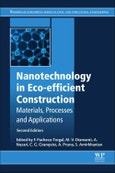Covering the latest technologies, Nanotechnology in eco-efficient construction provides an authoritative guide to the role of nanotechnology in the development of eco-efficient construction materials and sustainable construction. The book contains a special focus on applications concerning concrete and cement, as nanotechnology is driving significant development in concrete technologies. The new edition has 14 new chapters, including 3 new parts: Mortars and concrete related applications; Applications for pavements and other structural materials; and Toxicity, safety handling and environmental impacts.
Civil engineers requiring an understanding of eco-efficient construction materials, as well as researchers and architects within any field of nanotechnology, eco-efficient materials or the construction industry will find this updated reference to be highly valuable.
Please Note: This is an On Demand product, delivery may take up to 11 working days after payment has been received.
Table of Contents
1. Introduction to nanotechnology in eco-ef?cient construction F. Pacheco-Torgal
Part 1. Mortars and concrete related applications 2. In?uence of nanoparticles on the strength of ultra-high performance concrete Ksenija Jankovic, Dragan Bojovic and Marko Stojanovic 3. The effect of nanoparticles on the self-healing capacity of high performance concrete J.L. García Calvo, G. Pérez, P. Carballosa, E. Erkizia, J.J. Gaitero and A. Guerrero 4. The impact of graphene oxide on cementitious composites Alyaa Mohammed, Jay G. Sanjayan, Ali Nazari and Nihad T.K. Al-Saadi 5. Application of nanomaterials in alkali-activated materials Q.L. Yu 6. Effects of nano?bers on properties of geopolymer composites Akm Samsur Rahman 7. Nanoindentation for evaluation of properties of cement hydration products Saptarshi Sasmal and M.B. Anoop
Part 2. Applications for pavements and other infrastructure materials 8. Performance of asphalt mixture with nanoparticles Shaban Ali Zangena 9. Nanomodi?ed asphalt mixture with enhanced performance Shuaicheng Guo, Xu Yang, Zigeng Wang, Lingyun You, Qingli Dai and Zhanping You 10. Effects of graphene oxide on asphalt binders Yuanyuan Li, Shaopeng Wu and Serji Amirkhanian 11. NanoComposites for structural health monitoring Qiaofeng Zheng, Baoguo Han and Jinping Ou 12. Concrete with nanomaterials and ?bers for self-monitoring of strain and cracking subjected to ?exure Yining Ding, Genjin Liu, Zhibo Han, F. Pacheco-Torgal and Antonio Augusto Veloso de Costa 13. Icephobic nanocoatings for infrastructure protection Zaid Ayaz Janjua 14. Self-healing nanocoatings for protection against steel corrosion Alicja Stankiewicz 15. Nanocoatings for protection against steel corrosion A. Pruna 16. Fire retardant nanocoating for wood protection L.N. Vakhitova
Part 3. Applications for building energy ef?ciency 17. Aerogel-enhanced insulation for building applications U. Berardi 18. Nano aerogel windows and glazing units for buildings' energy ef?ciency Muhammad Abdul Mujeebu 19. Smart perovskite-based technologies for building integration: a cross-disciplinary approach Alessandro Cannavale and Francesco Martellotta 20. Electrochromic glazing for energy ef?cient buildings Claes Goran Granqvis 21. VO2-based thermochromic materials and applications: ?exible foils and coated glass for energy building ef?ciency Xun Cao, Ping Jin and Hongjie Luo
Part 4. Photocatalytic applications 22. Photocatalytic performance of mortars with nanoparticles exposed to the urban environment Maria Vittoria Diamanti and MariaPia Pedeferri 23. Multifunctional photocatalytic coatings for construction materials Marisol Faraldos and Ana Bahamonde 24. Self-cleaning ef?ciency of nanoparticles applied on facade bricks Magdalena Janus and Kamila Zajac 25. Nanotreatments to inhibit microalgal fouling on building stone surfaces Giovanni Battista Goffredo, Stefano Accoroni and Cecilia Totti 26. Self-cleaning cool paints Hideki Takebayashi 27. Photocatalytic water treatment Lev Matoh, Bostjan Zener, Romana Cerc Koro sec and Urska Lavrencic Stangar
Part 5.Toxicity, safety handling and environmental Impacts 28. Toxicity of nanoparticles Cristina Buzea and Ivan Pacheco 29. Risk management: controlling occupational exposure to nanoparticles in construction F. Silva, P. Arezes and P. Swuste 30. Measurement techniques of exposure to nanomaterials in workplaces Riccardo Ferrante, Fabio Boccuni, Francesca Tombolini and Sergio Iavicoli 31. Life-cycle assessment of engineered nanomaterials Stefano Cucurachi and Carlos Felipe Blanco Rocha








